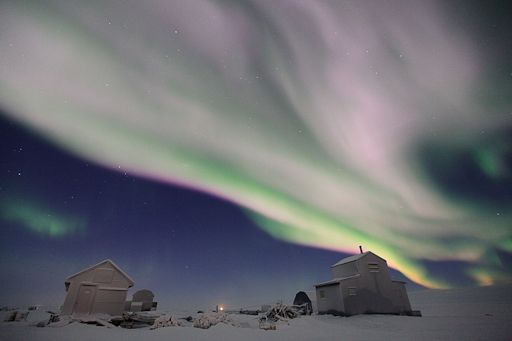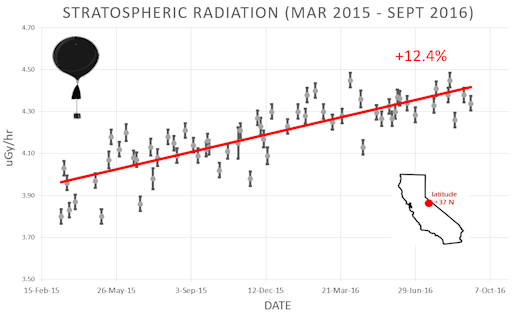Bring in the New Year with Marianne's Arctic Xpress. Spend Christmas or New Year in a remote Norwegian cabin. Chase auroras every night or join a day tour to see fjords, whales, eagles and an abundance of wildlife. Book Now | | | THE SOLAR WIND CONTINUES TO BLOW: For the fourth day in a row, Earth is inside a stream of solar wind blowing out of a large hole in the sun's atmosphere. This is causing magnetic unrest and bright auroras around the poles. Wind speeds are expected to exceed 600 km/s for at least one more day, so Arctic sky watchers should remain alert for auroras on Dec. 25th. Free: Aurora Alerts. PINK CHRISTMAS: Intense pink auroras are dancing around the Arctic Circle on Christmas Day 2016. James Helmericks sends this picture from the Colville River Delta in northern Alaska: 
"This was the brightest pink display I have ever seen, at one time even giving the snow a pink tinge," he says. Pink is a sign of electrons from space penetrating unusually deep in Earth's atmosphere and colliding with nitrogen molecules less than 100 km above the planet's surface. Realtime Aurora Photo Gallery GEOGRAPHY QUIZ: If the sky is green, the ground is white, and the photographer is wearing a red hat, where are you? Check out this image, then scroll down for the answer: 
Answer: Abisko, Sweden. "Last night I worked on Christmas Eve during the Lights Over Lapland Christmas special in Abisko," says photographer Oliver Wright. "We had snow all night and auroras for more than an hour, so I had to use the opportunity to get a Christmas aurora selfie." "This is the first time I've photographed auroras through snow, so Earth must be still be inside that solar wind stream," he adds. Indeed it is. Earth has been inside the stream for 4 days, and should remain inside for at least another day or so. Perhaps Oliver Wright won't be the only man in a red hat sighted amongst the green. Stay tuned!
Realtime Space Weather Photo Gallery
Realtime Airglow Photo Gallery
Realtime Sprite Photo Gallery Every night, a network of NASA all-sky cameras scans the skies above the United States for meteoritic fireballs. Automated software maintained by NASA's Meteoroid Environment Office calculates their orbits, velocity, penetration depth in Earth's atmosphere and many other characteristics. Daily results are presented here on Spaceweather.com. On Dec. 25, 2016, the network reported 4 fireballs.
(4 sporadics)  In this diagram of the inner solar system, all of the fireball orbits intersect at a single point--Earth. The orbits are color-coded by velocity, from slow (red) to fast (blue). [Larger image] [movies] Potentially Hazardous Asteroids ( PHAs) are space rocks larger than approximately 100m that can come closer to Earth than 0.05 AU. None of the known PHAs is on a collision course with our planet, although astronomers are finding new ones all the time. On December 25, 2016 there were potentially hazardous asteroids. Notes: LD means "Lunar Distance." 1 LD = 384,401 km, the distance between Earth and the Moon. 1 LD also equals 0.00256 AU. MAG is the visual magnitude of the asteroid on the date of closest approach. | | Cosmic Rays in the Atmosphere |
Readers, thank you for your patience while we continue to develop this new section of Spaceweather.com. We've been working to streamline our data reduction, allowing us to post results from balloon flights much more rapidly, and we have developed a new data product, shown here: 
This plot displays radiation measurements not only in the stratosphere, but also at aviation altitudes. Dose rates are expessed as multiples of sea level. For instance, we see that boarding a plane that flies at 25,000 feet exposes passengers to dose rates ~10x higher than sea level. At 40,000 feet, the multiplier is closer to 50x. These measurements are made by our usual cosmic ray payload as it passes through aviation altitudes en route to the stratosphere over California. What is this all about? Approximately once a week, Spaceweather.com and the students of Earth to Sky Calculus fly space weather balloons to the stratosphere over California. These balloons are equipped with radiation sensors that detect cosmic rays, a surprisingly "down to Earth" form of space weather. Cosmic rays can seed clouds, trigger lightning, and penetrate commercial airplanes. Furthermore, there are studies ( #1, #2, #3, #4) linking cosmic rays with cardiac arrhythmias and sudden cardiac death in the general population. Our latest measurements show that cosmic rays are intensifying, with an increase of more than 12% since 2015: 
Why are cosmic rays intensifying? The main reason is the sun. Solar storm clouds such as coronal mass ejections (CMEs) sweep aside cosmic rays when they pass by Earth. During Solar Maximum, CMEs are abundant and cosmic rays are held at bay. Now, however, the solar cycle is swinging toward Solar Minimum, allowing cosmic rays to return. Another reason could be the weakening of Earth's magnetic field, which helps protect us from deep-space radiation. The radiation sensors onboard our helium balloons detect X-rays and gamma-rays in the energy range 10 keV to 20 MeV. These energies span the range of medical X-ray machines and airport security scanners. The data points in the graph above correspond to the peak of the Reneger-Pfotzer maximum, which lies about 67,000 feet above central California. When cosmic rays crash into Earth's atmosphere, they produce a spray of secondary particles that is most intense at the entrance to the stratosphere. Physicists Eric Reneger and Georg Pfotzer discovered the maximum using balloons in the 1930s and it is what we are measuring today. | | The official U.S. government space weather bureau | | | The first place to look for information about sundogs, pillars, rainbows and related phenomena. | | | Researchers call it a "Hubble for the sun." SDO is the most advanced solar observatory ever. | | | 3D views of the sun from NASA's Solar and Terrestrial Relations Observatory | | | Realtime and archival images of the Sun from SOHO. | | | from the NOAA Space Environment Center | | | a proud supporter of science education and Spaceweather.com | | | the underlying science of space weather |  | Beautyz for top beauty products reviews and their buying guides | | | These links help Spaceweather.com stay online. Thank you to our supporters! | | 
